Translate this page into:
Application of Box-Behnken design for optimization of Vernonia amygdalina stem bark extract in relation to its antioxidant and anti-colon cancer activity
⁎Corresponding author. fauzan.lubis@usu.ac.id (Muhammad Fauzan Lubis)
-
Received: ,
Accepted: ,
This article was originally published by Elsevier and was migrated to Scientific Scholar after the change of Publisher.
Abstract
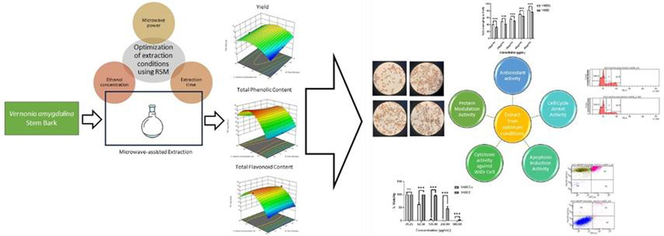
Abstract
Vernonia amygdalina is a popular plant used both in traditional medicine and as a culinary herb, one of which is anticancer. Microwave-assisted extraction (MAE) is reported to have the advantage of producing extracts with better phenol and flavonoid content so that the anticancer potential of the extract increases. This study was conducted to produce the polyphenol-rich extract of V. amygdalina stem bark as an anticancer. Responses Surface Methodology (RSM) was used to determine the optimum conditions for extracting phenolics and flavonoids from V. amygdalina stem bark. The total phenolic and flavonoid contents were carried out using a colorimetry assay. The antioxidant activity of the extract from optimal conditions (VABEEo) and extract from non-optimum conditions (VABEE) was determined using the DPPH method to support its anticancer activity. Meanwhile, the anticancer activity of the VABEEo was established through several tests which as cytotoxic test using MTT assay, cell cycle arrest and apoptosis activity using flow cytometer, and protein expression with immunocytochemical analysis. This research informs that the highest yield, total phenolic content (TPC), and total flavonoid content (TFC) were obtained respectively at 7.402 g, 73.634 mg GAE/g, and 64.466 mg QE/g at a microwave power of 450 W for 3 min and using a solvent with a concentration of 76.19 %. In addition, the antioxidant and cytotoxic activity of the VABEEo was 25.413 ± 0.525 µg/mL, higher than VABEE was 41.254 ± 0.614 µg/mL. In vitro studies show that VABEEo inhibits colon cancer growth by inducing cell cycle arrest at G1 stages, increasing apoptosis, and decreasing Cyclin D1/p53 levels. This study showed the application of RSM is successful for VABEEo preparation using MAE. Moreover, the VABEEo indicates promising potential for further research as a colon cancer treatment via in vitro tests.
Keywords
Vernonia amygdalina
Microwave-assisted extraction
Response surface methodology
Antioxidant
Cell cycle arrest
Apoptosis
Immunocytochemical
1 Introduction
Colon cancer ranks as the third most prevalent kind of cancer. It has high mortality rates and is a significant worldwide health issue. Chemotherapy is the predominant treatment for colon cancer, despite its drawbacks including harmful effects on healthy cells and the development of drug resistance in cancer cells over time (Illian et al., 2021). For many years, natural products have been a significant source of studies for drug development, leading to the creation of numerous new-generation chemotherapeutic medicines (Guo et al., 2023). Several natural products that showed anti-colon cancer activity include phenolic and flavonoids (Riahi-Chebbi et al., 2019). These two compounds are reported to be widely spread in medicinal plants (Syaftar et al., 2018). Therefore, the anti-colon cancer activity of medicinal plants has been reported in the previous study. As reported by Kim et al., 2021, the Sesamum indicum L. leaf attenuated the growth of human colon cancer cells. In addition, the methanol extract of Coleus amboinicus exhibited antiproliferative activity and induced programmed cell death in colon cancer cells (Laila et al., 2020). Moreover, Min et al., 2015 described the activity of Sasa quelpaertensis leaf against colon cancer in vitro and in vivo. These studies revealed that medicinal plants are no doubt to develop as an anti-colon cancer treatment.
The practice of employing herbal medicine for treating and controlling diseases is widespread in Asia, with particular emphasis on its prevalence in Indonesia (Elfahmi et al., 2014). Vernonia amygdalina Delile, a member of the Asteraceae family, is a plant/herb employed for this particular objective. V. amygdalina, known as “bitter leaf,” is frequently referred to as such in English (Mahadevi and Kavitha, 2020; Ijeh and Ejike, 2011). V. amygdalina is a botanical species that is characterized by its high content of essential nutrients, including fats, proteins, fibers, minerals, amino acids, carbohydrates, and vitamins (Kadiri and Olawoye, 2016). V. amygdalina is a botanical species that has been widely employed in traditional and folk medicinal traditions for the purpose of addressing various health conditions, with a particular focus on the treatment of dysentery and gastrointestinal disorders (Olamide and Agu, 2013; Adefisayo et al., 2017). Additional studies have documented various activities associated with different components of V. amygdalina. For instance, the stem bark of V. amygdalina has been found to possess notable antidiabetic and anthelmintic properties, surpassing the efficacy observed in the leaf and root parts (IfedibaluChukwu et al., 2020). The pharmacological activity of a substance is influenced by various factors, one of which is the composition of secondary metabolites including phenolic and flavonoid contents (Li et al., 2020). It has been reported that V. amygdalina contains various phytochemical compounds, such as Vernodalin, Vernoniosides D and E, Vernodalol, Vernoniosides A1, A2, A3, B1, Phytol, phenolic, and flavonoid (Ugbogu et al., 2021; Hasibuan et al., 2020). Additionally, it is imperative to consider and enhance the extraction procedure of medicinal plants to achieve the maximum quantity of chemical constituents in the resulting extract (Azmir et al., 2013).
The extraction process plays a crucial role in the progress of medicinal plants. Extraction is a systematic process that entails the isolation of chemical compounds found in medicinal plants by employing designated solvents and methodologies (Nortjie et al., 2022). The effectiveness of the extraction process for acquiring chemical compounds from medicinal plants depends on the chosen extraction methodology (Abubakar and Haque, 2020). The quantities extracted of chemical compounds can significantly influence the pharmacological activity, such as phenol and flavonoid (Sepahpour et al., 2018). Multiple studies have demonstrated that extracts characterized by elevated concentrations of phenolic and flavonoid compounds manifest enhanced anticancer properties when contrasted with extracts possessing lower phenolic and flavonoid content (Aryal et al., 2019; Muniyandi et al., 2019; Raphaelli et al., 2021). This compound demonstrates a wide range of properties and potential advantages, particularly in medicine, including its potential as antioxidant (Martins et al., 2016) and a therapeutic agent for colon cancer (Lee et al., 2016; Sharma et al., 2018). To optimize the concentration of phenolic and flavonoid compounds in the extract, careful consideration must be given to the choice of extraction technique utilized. As demonstrated by empirical evidence, the acquisition of chemical constituents can be significantly influenced by variations in extraction techniques. Based on available reports, it has been observed that the MAE technique has a significant influence on the binding of variables in the extraction process in comparison to alternative methods like maceration, reflux, and soxhletation (Gallo et al., 2010; Zhang, Yang and Wang, 2011; Dahmoune et al., 2015). MAE is a modern extraction technique that utilizes microwaves to enhance the efficiency and simplification of the extraction process. To enhance the efficiency of extraction results, it is imperative for MAE implementations to consider multiple factors, including microwave power, extraction time, and concentration of the solvent (Kapadia et al., 2022). Several studies have revealed significant disparities in the levels of phenolic and flavonoid compounds under different conditions (Routray and Orsat, 2014; Chaves et al., 2020).
The optimization of the extraction process can be achieved through the implementation of various methods. One commonly employed approach involves the utilization of RSM in conjunction with Box-Behnken Design (BBD) (Madondo, Rathilal and Bakare, 2022). To optimize the extraction process, it is crucial to identify and assess the independent variables, followed by developing a comprehensive strategy to establish the experimental conditions. Numerous research studies have provided evidence that RSM can predict the optimal extraction conditions required to attain the highest levels of total phenols and flavonoids from medicinal plants (Carciochi and Dimitrov, 2015; Park et al., 2022). The utilization of the method of MAE in conjunction with RSM was reported for the purpose of optimizing the polyphenol content of Coriander seeds (Zeković et al., 2016). In a recent study, the utilization of MAE and RSM was employed concurrently to optimize the phenolic content of Avocado seeds (Weremfo et al., 2020). This specific combination has been employed to augment the polyphenolic composition of Soybean meal (Woumbo et al., 2021). Hence, this study aims to produce the polyphenol-rich extract of V. amygdalina stem bark using MAE with RSM approach and test the VABEEo as anti-colon cancer activity via in vitro study. The BBD methodology was employed to establish treatment conditions encompassing microwave power, extraction time, and solvent concentrations variables, aiming to obtain VABEEo. In addition, the extract was evaluated for its antioxidant activity using MTT assay, and anticancer properties on WiDr cells, focusing on assessing its effects on cell cycle arrest, induction of apoptosis, and modulation of protein expression.
2 Materials and methods
2.1 Plant source
The stem bark of V. amygdalina was procured from the botanical garden affiliated with the Faculty of Pharmacy at Universitas Sumatera Utara, Indonesia. The Herbarium Medanese, a botanical institution associated with Universitas Sumatera Utara, subsequently verified the specimen and allocated the voucher number “1035/BC/HM-USU-2023″. The stem bark of V. amygdalina was subjected to drying by keeping the sample in the drying cabinet at a temperature of 40 °C for 72 h. Subsequently, the dried material was crushed and filtered through a mesh size 20 and kept at room temperature before use.
2.2 Material and chemical
The absolute ethanol (Sigma-Aldrich Co. Ltd.) as an extraction solvent was prepared to different concentrations of 50 to 90 % with added distilled water based on the experimental design (Table 1). The chemical reagents, including methanol, Folin-Ciocalteu, aluminum chloride (AlCl3), gallic acid, quercetin, 2,2-diphenyl-1-picryl-hydrazyl-hydrate (DPPH), 3-(4,5-dimethylthiazol-2-yl)-2,5-diphenyltetrazolium bromide (MTT), and anhydrous dimethyl sulfoxide (DMSO), were obtained from Sigma-Aldrich (St. Louis, MO, USA). The reagents for the anti-cancer test include Roswell Park Memorial Institute (RPMI), phosphate-buffered saline (PBS), and trypsin purchased from Gibco, USA, whereas propidium iodide (PI) and annexin V staining from Sigma-Aldrich. Furthermore, sodium hydroxide solution (SDS) and chloride acid were obtained from Merck, Germany. The antibody specific of anti-p-p53 and anti-Cyclin D1 obtained from Abclonal Science, Inc. The additional reagents used in this experiment were of analytical grade and supplied by the Parasitology Laboratory, Universitas Gadjah Mada, Yogyakarta, Indonesia.
Parameters
Microwave Power (A)
Extraction Time (B)
Ethanol Concentrations (C)
100 to 450 W
3 to 14 min
50 to 90 %
2.3 Extract preparation
The determination of the optimal extraction condition for the crude extract from V. amygdalina stem bark was conducted using a modified microwave (Samsung me731k, Seoul, South Korea) and the RSM with Design-Expert software (version 13.0, Stat-Ease, Inc., Minneapolis, MN, USA). The BBD was chosen based on its high efficiency in experimentation and utilized to optimize the extraction variables. These variables of microwave power (A) range from 100 to 450 W, extraction time (B) range from 3 to 14 min, and ethanol concentration (C) range from 50 to 90 %. A comprehensive set of 17 treatments was employed, as indicated in Table 2. The optimal extraction parameters were determined through the utilization of response surface and desirability function analysis. Three experiments were conducted in ideal conditions to ensure the model's accuracy.
Run
Independent variables
Response variables
A (Watt)
B (Minutes)
C
(%)
Yield value (gram)
TPC (mg GAE/g sample)
TFC (mg QE/g sample)
1
450
14
70
6.45
75.21
51.12
2
300
3
90
5.67
51.67
41.25
3
450
3
70
7.36
71.23
58.21
4
300
14
50
4.89
42.12
24.56
5
300
8.5
70
6.21
70.23
60.12
6
100
3
70
6.02
74.23
65.24
7
300
14
90
5.12
49.03
37.34
8
100
8.5
50
3.97
29.23
21.24
9
100
14
70
7.09
68.91
62.33
10
300
3
50
3.21
25.89
19.24
11
450
8.5
50
3.75
18.23
20.12
12
300
8.5
70
7.23
69.23
62.33
13
300
8.5
70
6.87
68.12
70.23
14
300
8.5
70
6.69
72.75
68.64
15
100
8.5
90
5.12
50.12
42.24
16
450
8.5
90
5.09
53.23
52.23
17
300
8.5
70
8.23
77.98
59.34
In this study, each treatment involved adding 30 g of V. amygdalina stem bark into a 5 L round-bottom flask. The experimental conditions were implemented following the specified design, as outlined in Table 2. Following the extraction process, the extracted materials underwent filtration using Whatman No. 1 filter paper (manufactured by Schleicher & Schuell, located in Keene, New Hampshire). Subsequently, the filtrate was subjected to drying using a freeze drier (manufactured by Il-shin Biobase, located in Goyang, Korea). The VABEEo was stored at −20 °C for subsequent investigations (de la Fuente et al., 2022). Meanwhile, the maceration of V. amygdalina stem bark has been conducted according to the report by Lubis et al., 2023c to gain the VABEE.
2.4 Total phenolic and total flavonoid contents evaluation
The TPC and TFC of crude extracts were evaluated using the Folin-Ciocalteu assay and the aluminum chloride with colorimetric method, respectively (Lubis et al., 2022b). Briefly, the TPC was determined with mixed of 100 μL of extract (500 μg/mL) with 7.9 mL of distilled water and 0.5 mL of Folin-Ciocalteu’s reagent (1:10 v/v). After mixing, 1.5 mL of 20 % aqueous sodium bicarbonate was added, and the mixture was allowed to stand for 90 min within termittent shaking. The absorbance was measured at 775 nm using a spectrophotometer. Meanwhile, the TFC was conducted with mixed 2 mL of extract (500 μg/mL) with 0.10 mL of 10 % aluminum chloride (AlCl3·6H2O), 0.10 mL of sodium acetate (NaC2H3O2·3H2O) (1 M), and 2.80 mL of distilled water. After incubation of 40 min, absorbance was measured at 432 nm using a spectrophotometer. The determination of TPC and TFC of extract followed the standard determination which of the units of measurement for TPC were expressed as gallic acid equivalent (GAE) (mg) per dry weight sample (g). In contrast, the units of measurement for TFC were expressed as quercetin equivalent (QE) (mg) per dry weight sample (g).
2.5 Determination of antioxidant activity
Antioxidant activity is assessed using the DPPH-radical scavenging test on an VABEEo and VABEE. The test involves combining each sample solution in various concentrations of 10.00; 20.00; 30.00; 40.00; and 50.00 μg/mL with a 0.2 mM DPPH solution, maintaining the mixture in a controlled environment, and measuring absorbance at 517 nm using a spectrophotometer. (model UV-2101PC, Shimadzu, Kyoto, Japan) with distilled water serving as the reference solution (Dalimunthe et al., 2023).
2.6 Anti-colon cancer activity of extract against WiDr cells
2.6.1 Preparation of cancer cell
The WiDr cell line is housed within the Parasitology Laboratory at Gadjah Mada University in Yogyakarta, Indonesia. The cells that have reached confluence in the flask must undergo subculture treatment. The media containing the subculture was subsequently removed from the flask, and a volume of 10 mL of PBS was introduced into the flask to cleanse it of any remaining media. Subsequently, the cell-containing media was also depleted of the PBS. Subsequently, a volume of 5 mL of trypsin with a concentration of 0.125 % was introduced into the flask containing the cells. The flask was then placed in a CO2 incubator set at 37 °C for 5 min. Thus, under these conditions, the cell within the incubator would undergo suspension (Lubis et al., 2023a).
2.6.2 Cytotoxic test
The cytotoxic activity of the extract, which was prepared under optimal conditions, was assessed using the MTT assay. In this study, cellular cultures were cultivated in 96-well plates (Iwaki, Japan) using a complete RPMI medium for 24 h. The preparation method for each VABEEo and VABEE was as follows: A stock solution with a concentration of 100,000 µg/mL was prepared by adding 10 mg of extract to 100 mL of DMSO. The stock solution was diluted using a complete RPMI medium to achieve concentrations of 500, 250, 125, 62.5, and 31.25 µg/mL for subsequent use in treatments. The experiment was conducted with three replicates for each concentration. In 96-well plates, 1 × 104 WiDr cells were planted per well and incubated for 48 h. The cell culture medium was aspirated from the plate, and subsequently, 100 µL of fresh medium containing varying concentrations of the extract was introduced into each well. The plate was then incubated for 24 h. The viability of cells was assessed using the MTT assay. The cell culture medium was aspirated, and subsequently, 100 µL of MTT reagent, which had been prepared by dissolving it in 1 mL of PBS and diluting it with 9 mL of RPMI medium, was added to each well. The plate was incubated in a light-restricted environment for 3 to 4 h. After the experimental procedure, 100 µL of a stop solution was introduced into each well. This stop solution was composed of 10 % SDS dissolved in chloride acid at a concentration of 0.1 N. The plate was subsequently placed in a dark room at ambient temperature and incubated overnight. The absorbance measurements were recorded using an ELISA reader (Bio-Rad, USA) at a wavelength of 595 nm. The absorbance of each well was transformed into the percentage of viable cells using the following method (1) (Lubis et al., 2023b).
2.6.3 Extract induced cell cycle arrest and apoptosis
Cell cycle distribution was assessed using PI staining, followed by flow cytometry analysis. In the present investigation, WiDr cells were exposed to a treatment involving a concentration equivalent to half of the IC50 of the VABEEo for 24 h. The cells (5 x 105) were then subjected to a staining solution comprising PI/RNase (40 mg/mL of PI and 100 mg/mL of RNase). Subsequently, the cells were incubated at a temperature of 4 °C overnight. DNA content was quantified in each cell using flow cytometry, employing the CyAn ADP Analyzer manufactured by Beckman Coulter, a renowned company based in the United States (Hasibuan et al., 2020). The assessment of apoptotic cells was conducted utilizing the Annexin V-FITC (fluorescein isothiocyanate)/PI co-staining assay. In summary, after a 24-hour incubation period, the cellular samples were gathered and centrifuged at a rate of 1800 rpm for 8 min. The pellet was rehydrated in a solution containing 50 μL of binding buffer, supplemented with 0.5 μL of Annexin V-FITC. Following this, the mixture underwent incubation at a temperature of 4 °C for 30 min under conditions of light deprivation. Each tube was supplemented with a solution of PI at a concentration of 50 μg/mL, containing 200 μL of binding buffer. Subsequently, the tubes were subjected to an incubation period lasting 5 min. Following that, the cells were subjected to analysis using flow cytometry (Lubis et al., 2023b).
2.6.4 Cyclin D1 and p53 expressions
The WiDr cells (5 x 105 cells/well) were cultured in 100 mm culture dishes for an extended time, expressly overnight, and then treated with the extract for 24 h. The cells that were gathered underwent a treatment procedure and were subsequently fixed using a solution containing 4 % paraformaldehyde. Following that, the cells were evenly distributed onto glass slides that had been coated with silane and left to air dry. The endogenous peroxidase activity was deactivated through a 10-minute exposure to a 3 % hydrogen peroxide solution. A solution consisting of 10 % bovine serum albumin in PBS was utilized to mitigate nonspecific binding. The target proteins were identified by immunostaining utilizing antibodies specific to anti-p-p53 and anti-Cyclin D1 (Satria et al., 2019).
2.7 Statistical analysis
The data were presented as the mean ± standard deviation of a minimum of three independent experiments (n = 3), with each experiment consisting of three sample replicates. To determine the individual linear, quadratic, and interaction regression coefficients (β), ANOVA was performed at p < 0.05. The analysis of several data will continue with a post hoc test, and the significant difference in data will expressed at p < 0.05. The fitness of the polynomial was estimated by employing the coefficient of determination (R2), and the significance of each coefficient was determined by p-values. Specifically, p-value ≤ 0.001, 0.001 < p-value ≤ 0.01, 0.01 < p-value ≤ 0.05, and p-value > 0.05 indicate that the model terms are remarkably significant, highly significant, significant, and not significant, respectively. Moreover, adequate precision was used to describe the signal-to-noise of greater than four. (Zhang et al., 2019).
3 Results and discussion
3.1 Response surface methodology modelling
The optimization of V. amygdalina stem bark extraction using MAE has been modeled using RSM. The experiment examined the impact of power (measured in watts), time (measured in hours), and solvent concentration (expressed as a percentage) on the yield, TPC, and TFC. The empirical findings are presented in Table 2. The experimental findings on the yield, TPC, and TFC in V. amygdalina extract fell within the ranges of 3.21–8.23 g, 18.23–77.98 mg GAE/g sample, and 19.24–70.23 mg QE/g sample, respectively. The analysis of variance (ANOVA) findings is presented in Table 3, displaying the calculated coefficient of determination (R2) and p values. These values assessed the interplay between the independent and dependent variables. The statistical analysis reveals low probability values (p < 0.05), indicating a high significance level. Additionally, the lack of fit is non-significant (p > 0.05). These findings suggest that the proposed model has the potential to effectively analyze and predict the extraction rate of yield, TPC, and TFC (Juliana et al., 2022; Naseem et al., 2022). The R2 in multiple correlation analysis quantifies the extent to which the predicted values of quadratic equations are related to their corresponding actual values (Elboughdiri et al., 2020). A: microwave power (watts); B: extraction time (min); C: ethanol concentration (%);. *: indicates significance level (0.01 < p-value ≤ 0.05); **: indicates highly significant level (0.001 < p-value ≤ 0.01); ***: indicates remarkably significant level (p-value ≤ 0.001). TPC: total phenolic content; TFC: total flavonoid content.
Source
Yield value
TPC
TFC
A
0.7116
0.6023
0.8436
B
0.5399
0.3208
0.6445
C
0.0459*
0.0005***
0.0040**
AB
0.3907
0.2901
0.7744
AC
0.9856
0.0997
0.4471
BC
0.1688
0.0616
0.4896
B2
0.9149
0.2322
0.2290
C2
0.0011**
<0.0001***
0.0002***
Intercept
6.86
70.41
63.62
R2
0.9228
0.9865
0.9624
Adjusted R2
0.7529
0.9568
0.8797
Predicted R2
0.7015
0.9295
0.8013
Lack of fit
0.68
0.3705
0.1275
The extraction models demonstrate a strong correlation between the observed and predicted values, as evidenced by the high R2 (R2 yield = 92.2 %, R2 TPC = 95.5 %, R2 TFC = 87.9 %) and R2Adj (R2Adj yield = 75.2 %, R2Adj TPC = 95.6 %, and R2Adj TFC = 80.1 %) values. Furthermore, the coefficient of variation (CV < 10 %) for each model indicates high accuracy and reliability (Pham et al., 2020). This finding further supports that the models can effectively predict experimental values. Based on the multiple regression analysis results conducted on the experimental data, the predictive model equation can be derived using the coefficients presented in Table 3. This equation is expressed as follows, specifically denoted as Eqs. (2), (3), and (4):
3.2 Effect of three independent variables on yield, Total Phenolic Content (TPC), and Total Flavonoid Content (TFC)
The regression analysis reveals the presence of a quadratic regression model that can effectively elucidate the association between the three independent variables and the yield, TPC, and TFC within the experimental range. According to the ANOVA results presented in Table 3, the quadratic terms exhibited a high significance level for the yield model, with a p < 0.05. Similarly, for the TPC and TFC models, the quadratic terms demonstrated an even higher significance level, with a p < 0.001. The analysis of independent factors revealed that variable C had a statistically significant impact on the yield, TPC, and TFC, with p-values of < 0.05; 0.0005; and 0.004, respectively. Furthermore, it was observed that all variables influenced by C2 exhibited a high significance level, with p-values of 0.001, < 0.0001, and 0.0002. Conversely, the variables A, B, AB, AC, and BC were found to be statistically insignificant.
Fig. 1a-C displays 3-d response surface and contour plots, which aim to enhance the visualization of the relationships between various experimental factors and their impact on the response variables. that illustrates the result of two independent variables on a dependent variable while holding the remaining variable constant. the observed trend inFig. 1a and 1b indicates an upward trend in yield as the A increased from 100 to 300 W. However, it is worth noting that the product experienced a slight decline after reaching 450 W (Fig. 1c). The yield exhibited a peak value when the other factor was set at a specific value. Meanwhile, the result shows only C has a significant impact on the yield (p < 0.05). It can be seen that the extraction process with A, of 100 W, requires B longer to obtain the optimum value, of 7 to 14 min with C around 70 up to 80 %. If A is increased to 300 W, then the B needed to achieve optimum yield is wider, of 3 to 14 min with C remaining at 70 to 80 %. Then when A is at 450 W, B is needed to achieve optimum yield around 3 to 5 min with C the same as the previous 2 conditions. This result described the yield optimum that will be gained if the C is around of 70 to 80 %.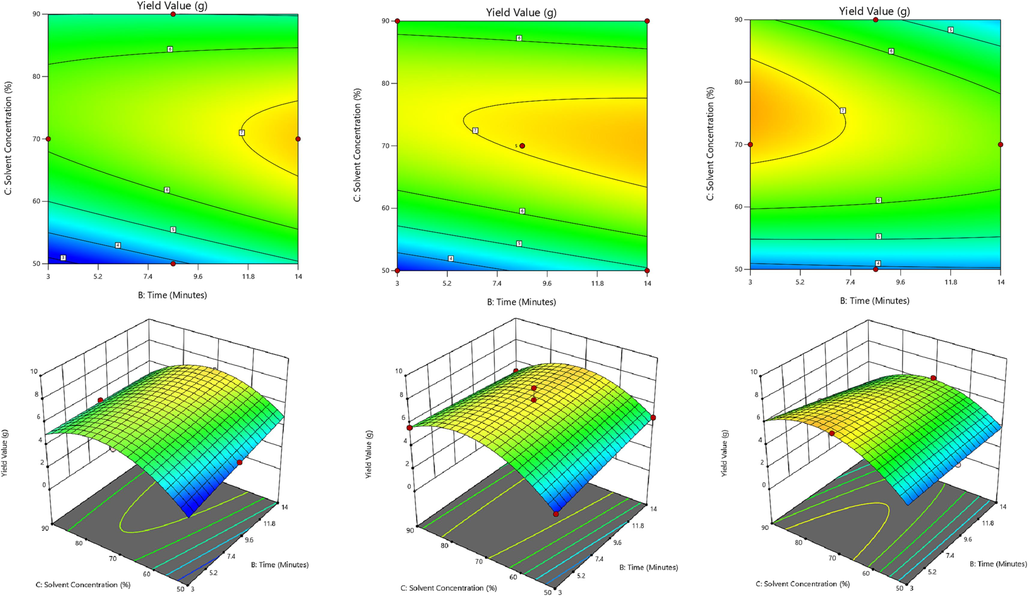
Contour plots and response surface of yield as a function of microwave power (A), extraction time (B), and ethanolic concentration (C) (1.a − 100 W, 1.b − 300 W, 1.c − 450 W).
Fig. 2a-C describes the effect of c significantly to achieve the optimum of tpc (p = 0.0005). The TPC will be increased if the C is around 70 to 80 %. If C decreases between 50 and 70 % with the reduction or addition of A and B, TPC will continue to decrease. The same thing also happens if C is increased to more than 80 %, TPC will decrease even though A and B are increased. In addition, C also has a significant effect on increasing and decreasing TFC compared to A and B (p = 0.004), as seen in Fig. 3a-c. The optimal TFC value is obtained when C is 70 to 80 % with A and B at the lowest and highest conditions. So it can be stated that C has a significant influence on the yield, TPC, and TFC results of the MAE results. This is supported by the ANOVA data that has been mentioned in Table 3. These results are explained from previous studies that C has a significant influence on the yield optimization process, TPC, and TFC. It was reported by Do et al., 2014 that the water content in the ethanol solvent influenced the activity in the extraction process, where 75 % ethanol gave a higher yield than 100 % ethanol. Similar to Alara et al., 2018, reported that the ethanol concentration of 76 % is the best solvent to obtain the optimum value of yield, TPC, and TFC using MAE. On the other hand, Alara et al., 2020 described that the percentage of ethanol concentration in the extraction medium has a significant on the recovery yield, TPC, and TFC of V. amygdalina leaf. The water in ethanol helps in swelling of the plant matrix and increases the contact surface area between the solvent and plant matrix, thereby resulting in an increasing extraction efficiency (Chew et al., 2011). However, it has been reported that other factors such as A and B also exerted significant influence in several previous studies. It is explained that an increase in microwave power will have an impact on temperature elevation. This results in a decrease in solvent viscosity, thus enhancing penetration and extraction processes (Rodriguez-Perez et al., 2016). Meanwhile, it is interesting to examine the effect of extraction time in the process. Increasing the extraction time will increase the amount of analyte in the extraction, but degradation can also occur. It is reported that the optimal time to obtain TPC and TFC using MAE ranges from 14 to 20 min (Azaroual et al., 2021). Unfortunately, this research did not show a significant influence of changes in microwave power and extraction time.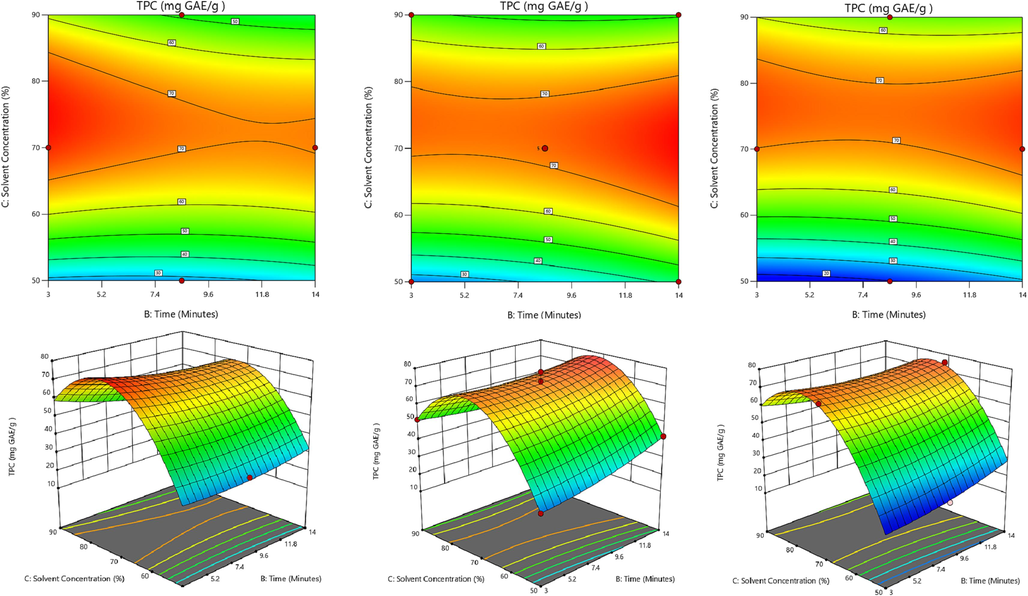
Contour plots and response surface of TPC as a function of microwave power (A), extraction time (B), and ethanolic concentration (C) (2.a − 100 W, 2.b − 300 W, 2.c − 450 W).
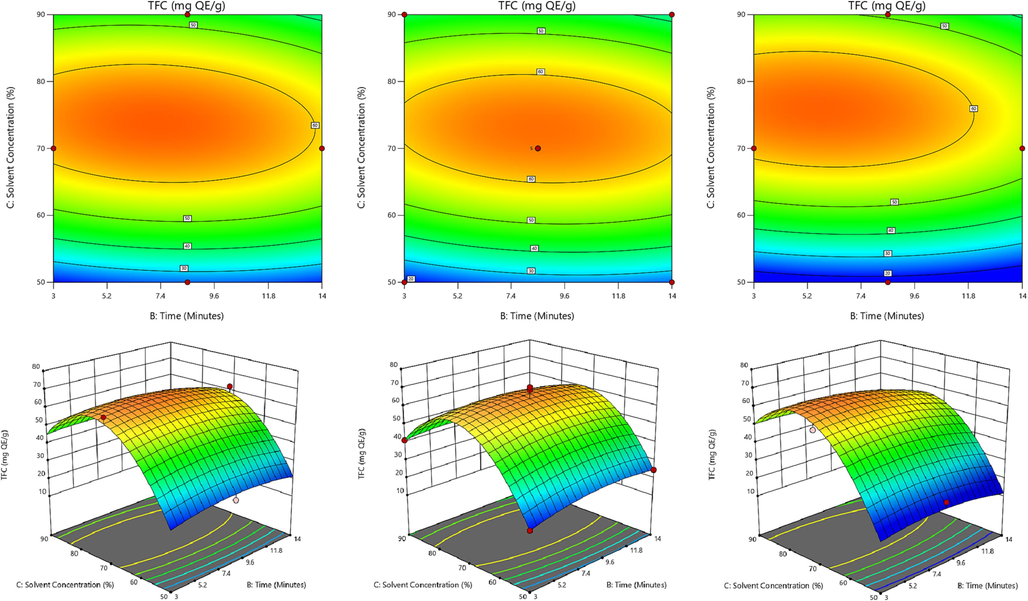
Contour plots and response surface of TFC as a function of microwave power (A), extraction time (B), and ethanolic concentration (C) (3.a − 100 W, 3.b − 300 W, 3.c − 450 W).
3.3 Model evaluation
The Design-Expert 13 software assessed the maximum predictive value of yield, TPC, and TFC for each factor. This analysis was conducted following the plot analysis. The optimal conditions for achieving the highest yield, TPC, and TFC were determined and are presented in Table 4. The experiments were conducted using the enhanced optimal conditions, which consisted of a power input of 450 W, a duration of 3 min, and an ethanol concentration of 76.19 %. These conditions were selected to maximize the yield, TPC, and TFC. The measurements were conducted in triplicate, and the results obtained for the yield, TPC, and TFC were as follows: 7.206 ± 0.693 g for yield, 75.893 ± 3.931 mg GAE/g sample for TPC, and 65.266 ± 6.191 mg QE/g sample for TFC (refer to Table 4). Previous studies have reported that V. amygdalina contains phenolics and flavonoids. As reported by Alara et al., 2020, the leaf of V. amygdalina has a TPC of 108.57 mg GAE/g, whereas the TFC of 91.12 mg QE/g. Meanwhile, in another report by Alara et al., 2019, the TPC and TFC of V. amygdalina leaves extract were established by soxhlet methods of 70.33 ± 2.11 mg GAE/g and 63.82 ± 0.99 mg QE/g. However, this study is the first report about the optimization of total phenolics and flavonoids from V. amygdalina stem bark after extraction using MAE. Hence, the process parameters utilized for extracting yield, phenolics, and flavonoids in V. amygdalina stem bark through the implementation of the BBD experimental design optimization are deemed to be precise and dependable while also possessing practical applicability.
Optimized conditions
Power (Watt)
450
Desirability
0.082
Time (Minutes)
3.00
Solvent concentrations (%)
76.19
Target
Predicted value
Experimental value
Response variables
Yield (g)
Maximum
7.402
7.206 ± 0.693
TPC (mg GAE/g)
Maximum
73.634
75.893 ± 3.931
TFC (mg QE/g)
Maximum
64.466
65.266 ± 6.191
3.4 Analysis of antioxidant activity
The DPPH assay is a widely employed standard method for the assessment of the antioxidant capacity of plant extracts (Vinci et al., 2022; Mandal et al., 2023). The Radical Scavenging Activity (RSA) values, which represent the concentration-dependent DPPH radical scavenging activity of the crude extracts of V. amygdalina stem bark obtained under optimal conditions, are depicted in Fig. 4. As anticipated, the RSA of both sample types demonstrated improvement with increasing concentration. According to the data presented in Fig. 4., it can be observed that the ethanolic extract of V. amygdalina stem bark, specifically the optimized variant (referred to as VABEEo), exhibited a DPPH scavenging activity exceeding 32.478 ± 1.185 % at a mass concentration of 10 µg/mL. Furthermore, as the mass concentration steadily increased, the scavenging activity of DPPH exhibited a peak value of 82.309 ± 0.298 % when the concentration reached 50 µg/mL. In comparison to the ethanolic extract obtained from the maceration process of V. amygdalina stem bark (referred to as VABEE), the scavenging activity of DPPH exhibited a significantly different maximum value of 77.012 ± 1.522 % (p < 0.0001) at an equivalent mass concentration. The IC50 values representing the scavenging activity of VABEEo and VABEE on DPPH radicals were determined to be 25.413 ± 0.525 µg/mL and 41.254 ± 0.614 µg/mL, respectively, as shown in Table 5. According to the findings of the antioxidant assessment, it was observed that the scavenging activity of VABEEo exhibited a slightly higher level than that of VABEE, and it was categorized as a strong activity (Batool et al., 2022). The antioxidant activity of V. amygdalina was confirmed in many studies. The ethanolic extract of V. amygdalina leaf has been reported to exhibit potential antioxidant activity with IC50 4.0 µg/mL (Patathananone et al., 2023). Whereas Hussen and Endalew, 2023 described the antioxidant activity of water, methanol, and ethanolic extracts of V. amygdalina leaf against DPPH radicals of 111.4; 94.92; and 94.83 μg/mL, respectively. Moreover, the methanol extract of V. amygdalina leaf was reported to have activity inhibit DPPH and ABTS radicals with percentage inhibition of 77 – 99.3 % and 96.2 – 100 % (Erasto et al., 2007). Finally, the antioxidant activity of V. amygdalina stem bark is not different compared to V. amygdalina leaf.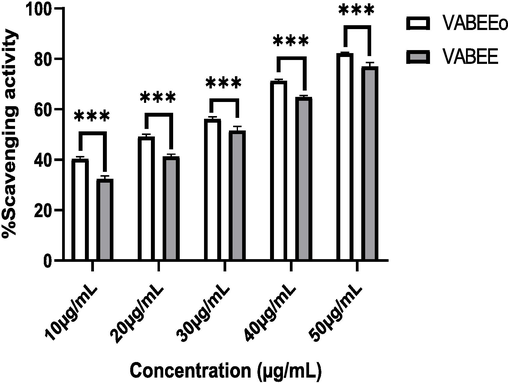
% Radical Scavenging Activity of VABEEo and VABEE against DPPH radical. Sample (n = 3 ± SD), ***significant different with p < 0.0001.
Sample
IC50 (µg/mL)
DPPH
Cytotoxic
VABEE
41.254 ± 0.614
288.434 ± 9.989
VABEEo
25.413 ± 0.525
70.940 ± 2.924
The VABEEo has been confirmed to contain phenolics and flavonoids, identified as potential contributors to its antioxidant activity (Drammeh et al., 2023). The increase in phenolics and flavonoids significantly impacts the inhibition of DPPH radicals. This was revealed by Mustafa et al., 2010, stating that the correlation between phenolics and flavonoids regarding their activity in inhibiting DPPH radicals is very strong, which of 0.8613 and 0.8430, respectively. Several phenolics and flavonoids, specifically quercetin, rutin, and chlorogenic acid, have been demonstrated to possess natural antioxidant properties (Tungmunnithum et al., 2018). The antioxidant activity of quercetin and its glycosides has been documented (Zheng et al., 2017). In particular extensive research has substantiated the antioxidant activity of rutin. It has been reported that rutin induces a notable elevation in catalase, glutathione (GSH) concentrations, and superoxide dismutase (SOD) enzymes (Abarikwu et al., 2017; Enogieru et al., 2018). Additionally, it has been reported that chlorogenic acid possesses inhibitory properties against nitric oxide production (Kim et al., 2017; Lemos et al., 2022).
3.5 Analysis of anti-colon cancer activity against WiDr cells
The WiDr cell line was utilized to assess the anticancer efficacy of VABEEo and VABEE. The findings depicted in Fig. 5 demonstrate that both VABEEo and VABEE exert dose-dependent inhibitory effects on the viability of WiDr cells. Notably, the highest concentration of these compounds resulted in a remarkable suppression of over 90 % after a 24-hour exposure. The study's findings demonstrate that VABEEo exhibits a significant inhibitory effect on the proliferation of WiDr cells, particularly when compared to VABEE at its highest concentration (p < 0.0001). The results of our investigation demonstrated a significant cytotoxic effect of VABEEo in comparison to VABEE, as evidenced by the IC50 values of 70.940 ± 2.924 µg/mL and 288.434 ± 9.989 µg/mL, respectively (refer to Table 4). If compared with previous studies about the cytotoxic activity of V. amygdalina¸the sample shows great activity against WiDr cells. The V. amygdalina leaf was reported to have activity against T47D cells with IC50 of 55.50 ± 0.79 µg/mL (Lifiani et al., 2018). Meanwhile, Yedjou et al., 2013 described the effect of V. amygdalina leaf against MCF-7 cells and it’s similar to the result reported by Fachrunisa et al., 2019. Recently, the cytotoxic activity of V. amygdalina has been explained by Hasibuan et al., 2024 against PANC-1 cells with IC50 of 21.19 ± 0.64 µg/mL. Another investigation established the cytotoxic effects of the ethanolic extract derived from the stem bark of V. amygdalina on PANC-1 cells, with an IC50 value of 118.62 ± 1.52 µg/mL (Lubis et al., 2022a).The studies showed that V. amygdalina has the potential activity to induce cancer cell death. There are several mechanisms that allow death to occur, including the formation of intracellular ROS, regulation of NF-nB, and the effects of local concentration and oxidative stress (Cao et al., 2020).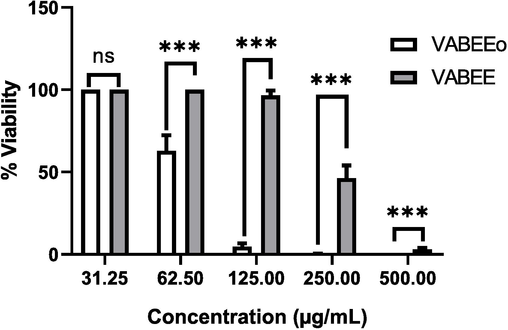
The effect of VABEEo and VABEE against % viability of WiDr cell with concentration depending. Sample (n = 3 ± SD), ***significant different with p < 0.0001.
The VABEEo has potential activity as anti-colon cancer against the WiDr cells. The mechanism of VABEEo as an anticancer was carried out through cell cycle arrest effect, apoptosis induction, and protein expression test. Fig. 6., describes the impact of VABEEo inducing cell cycle arrest. The ½ IC50 of VABEEo has the activity to induce cell cycle arrest on the G1 phase which is a cell accumulation of 63.420 ± 0.361 % (Fig. 6b). This accumulation of WiDr cells significantly increases on the G1 phase if the result is compared to the control group of 57.080 ± 0.783 % with p < 0.05 (Fig. 6c). In addition, the ½ IC50 of VABEEo identified lead apoptosis induction on late apoptosis and significantly different from the control group of 50.497 ± 0.810 % and 2.150 ± 0.066 %, respectively (Fig. 7). The sample was identified as causing necrosis. This may occur because the concentration of the test is too large (Kowalczyk et al., 2019). Several studies have reported the effect of V. amygdalina to inhibit the cell cycle and induce the apoptosis of cancer cells. As reported by Wong et al., 2013, V. amygdalina leaf inhibited the cell cycle in the G1/S phase of MCF-7 and induced apoptosis through modulation of p53. It is similar to reports by Hasibuan et al., 2020, the V. amygdalina leaf inhibited cell cycle progression on the G2/M phase via PI3K/mTOR pathways. Regardless, this study has proven the efficacy of V. amygdalina as an anticancer by inhibiting the cell cycle and promoting apoptosis.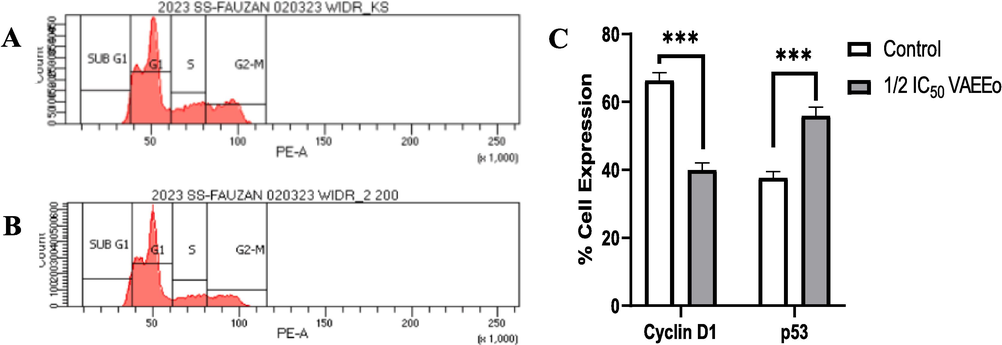
VABEEo at ½ IC50 has induce cell cycle arrest on G1 phase with *p < 0.05. Sample (n = 3 ± S D), (a) Control group, (b) VABEEo group, (c) % cell accumulation of WiDr after treatment with VABEEo.
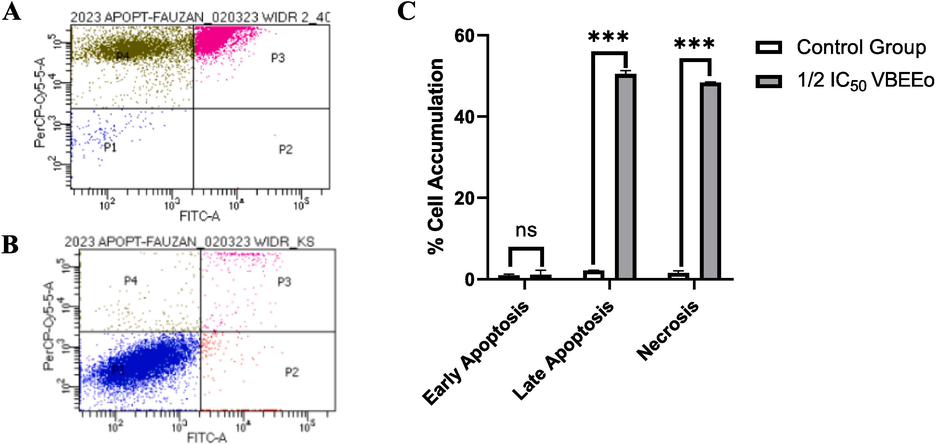
VABEEo at ½ IC50 has induced late apoptosis with p < 0.001 and significantly differs from a control group with ***p < 0.0001. Sample (n = 3 ± SD), (a) Control group, (b) VABEEo group, (c) % cell accumulation of WiDr after being treated with VABEEo.
This study aimed to investigate the potential mechanism of VABEEo in inducing cell cycle arrest and apoptosis. The present study is of significant interest as it addresses a notable research gap in the anticancer properties of the colon derived from V. amygdalina stem bark, for which no prior literature exists. The investigation involved the assessment of cyclin D1 and p53 expression using the immunocytochemical (ICC) technique. Our study discovered that the expression of cyclin D1 exhibited a significant decrease following treatment with VABEEo at a concentration of ½ IC50, resulting in a reduction of 40.010 ± 2.063 % (p < 0.0001), as shown in Fig. 7. The p53 expression exhibited a statistically significant increase (p < 0.0001) following administration of the VABEEo at a concentration of ½ IC50, resulting in a mean value of 55.957 ± 2.520 % (Fig. 8). Of course, many other factors initiate cancer cell death, such as the influence of other proteins (Hasan et al., 2018). Moreover, multiple studies have demonstrated the anticancer properties of phenolics and flavonoids concerning WiDr cells (Kopustinskiene et al., 2020). Apigenin, a polyphenol derived from V. amygdalina, has been found to possess anti-colon cancer properties. This compound has been reported to induce apoptosis by activating p53 and autophagy by inhibiting the mTOR/PI3K/Akt signaling pathway (Xu et al., 2016). Moreover, quercetin is a phenolic compound recognized for its role as an anticancer agent. The compound known as quercetin has demonstrated anti-colon cancer properties, as evidenced by its ability to induce apoptosis through downregulating Bax/Bcl-2 and inhibiting proliferation by suppressing COX-1, COX-2, and iNOS (Zhang et al., 2015). Luteolin has been reported as an additional polyphenol found in V. amygdalina. Luteolin has been observed to mitigate oxidative stress during the development of colon cancer, thereby providing cellular protection against damage in vivo. The Wnt/β-catenin signaling pathway, which undergoes dysregulation in the context of neoplastic progression, is subject to modification by luteolin (Pandurangan et al., 2013).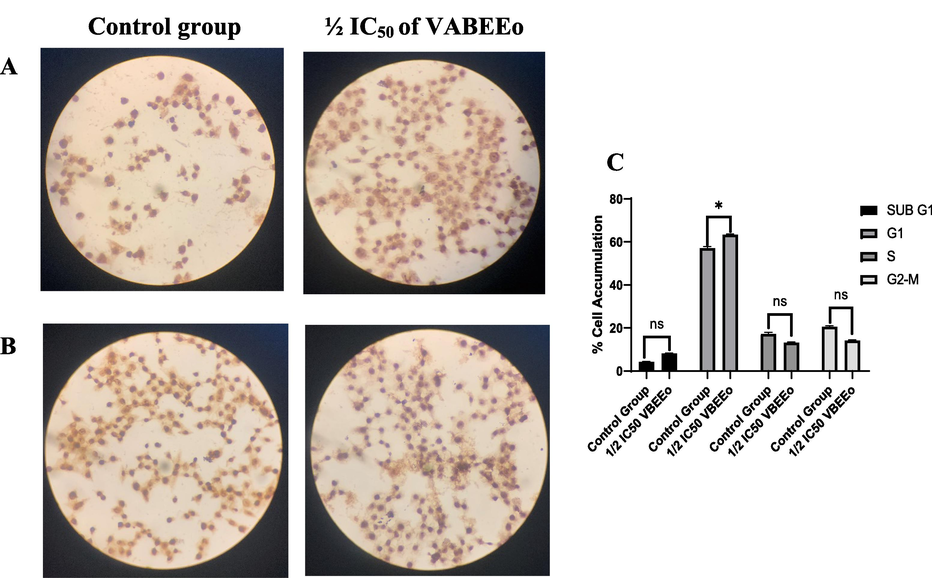
The effect of ½ IC50 VABEEo on protein expression using immunocytochemistry against WiDr cells with p < 0.001. The brown cells indicated protein was expressed with sample n = 3 ± SD and ***p < 0.0001. (a) Expression of Cyclin D1, (b) Expression of p53, and (c) % cell expression of WiDr.
4 Conclusions
The optimal conditions for MAE were determined as follows: a microwave power of 450 W was used for the extraction process, with an extraction time of 3 min and an ethanol concentration of 76.19 %. The extraction condition that was found to be optimal resulted in the highest yield of crude extract, TPC, and TFC, which closely aligned with the predicted value. In addition, it can be observed that the VABEEo exhibits superior antioxidant activity compared to VABEE. The VABEEo compound exhibits promising potential as an anti-colon cancer agent, particularly in its activity against WiDr cells. The VABEEo compound exhibited potent cytotoxicity against WiDr cells, leading to cell cycle arrest and enhanced apoptosis during the late phases. This effect was attributed to the inhibition of Cyclin D1 and upregulation of p53 expressions. Nevertheless, the phytochemical compounds of VABEEo remain poorly understood and require further investigation in a separate study. Furthermore, it is imperative to conduct a toxicological assessment of VABEEo to provide substantiation for the clinical investigation.
CRediT authorship contribution statement
Muhammad Fauzan Lubis: Conceptualization, Methodology, Supervision, Funding acquisition, Project administration, Writing review & editing. Sumaiyah Sumaiyah: Conceptualization, Investigation, Formal analysis, Project administration, Writing review & editing. Lokot Donna Lubis: Methodology, Investigation, Formal analysis. Khairani Fitri: Conceptualization, Supervision, Writing review & editing. Ririn Astyka: Methodology, Formal analysis, Investigation, Writing original draft.
Acknowledgments
The authors express their gratitude to Universitas Sumatera Utara and Universitas Gadjah Mada for providing the necessary tools and reagents essential to completing this research endeavor.
Declaration of competing interest
The authors declare that they have no known competing financial interests or personal relationships that could have appeared to influence the work reported in this paper.
References
- Rutin, an antioxidant flavonoid, induces glutathione and glutathione peroxidase activities to protect against ethanol effects in cadmium-induced oxidative stress in the testis of adult rats. Andrologia. 2017;49(7):1-12.
- [Google Scholar]
- Preparation of medicinal plants: basic extraction and fractionation procedures for experimental purposes. J. Pharm. Bioallied Sci.. 2020;12(1):1-10.
- [Google Scholar]
- Gastro-protective effect of methanol extract of Vernonia amygdalina (del.) leaf on aspirin-induced gastric ulcer in wistar rats. Toxicol. Rep.. 2017;13(4):625-633.
- [Google Scholar]
- Ethanolic extraction of bioactive compounds from Vernonia amygdalina leaf using response surface methodology as an optimization tool. J. Food Meas. Charact.. 2018;12:1107-1122.
- [Google Scholar]
- Extraction and characterization of bioactive compounds in Vernonia amygdalina leaf ethanolic extract comparing soxhlet and microwave-assisted extraction techniques. J Taibah Univ Sci. 2019;13(1):414-422.
- [Google Scholar]
- Ethanolic extraction of flavonoids, phenolics and antioxidants from Vernonia amygdalina leaf using two-level factorial design. J. King Saud Univ. Sci. 2020;32(1):7-16.
- [Google Scholar]
- Total phenolic content, flavonoid content and antioxidant potential of wild vegetables from western Nepal. Plants. 2019;8(4):96.
- [Google Scholar]
- Optimization of the microwave-assisted extraction of simple phenolic compounds from grape skins and seeds. Agronomy. 2021;11(8):1527.
- [Google Scholar]
- Techniques for extraction of bioactive compounds from plant materials: a review. J. Food Eng.. 2013;117(4):426-436.
- [Google Scholar]
- Green synthesis of Cordia myxa incubated ZnO, Fe2O3, and Co3O4 nanoparticle: characterization, and their response as biological and photocatalytic agent. Adv. Powder Technol.. 2022;33(11):103780
- [Google Scholar]
- Lipid-coated ZnO nanoparticles synthesis, characterization and cytotoxicity studies in cancer cell. Nano Converg. 2020;7(1):14.
- [Google Scholar]
- Optimization of antioxidant phenolic compounds extraction from quinoa (Chenopodium quinoa) seeds. J. Food Sci. Technol.. 2015;52(7):4396-4404.
- [Google Scholar]
- Extraction of flavonoids from natural sources using modern techniques. Front. Chem.. 2020;25(8):507887
- [Google Scholar]
- Effect of ethanol concentration, extraction time and extraction temperature on the recovery of phenolic compounds and antioxidant capacity of Orthosiphon stamineus extracts. Int. Food Res. J. 2011;18:1427-1435.
- [Google Scholar]
- Optimization of microwave-assisted extraction of polyphenols from Myrtus communis L. leaves. Food Chem.. 2015;166:585-595.
- [Google Scholar]
- Antioxidant activity of n-hexane, dichloromethane, ethyl acetate, and methanol extracts of Litsea cubeba lour. barks. Rasayan J. Chem.. 2023;16(02):642-647.
- [Google Scholar]
- Nutritional and bioactive oils from salmon (Salmo Salar) side streams obtained by soxhlet and optimized microwave-assisted extraction. Food Chem.. 2022;386:132778
- [Google Scholar]
- Effect of extraction solvent on total phenol content, total flavonoid content, and antioxidant activity of Limnophila aromatica. J. Food Drug Anal.. 2014;22(3):296-302.
- [Google Scholar]
- Phytochemistry of selected gambian traditional. Afr J. Chem. Educ.. 2023;13(1):144-161.
- [Google Scholar]
- Enhancing the extraction of phenolic compounds from juniper berries using the box-behnken design. ACS Omega. 2020;5(43):27990-28000.
- [Google Scholar]
- Elfahmi, Woerdenbag, H. J., and Kayser, O., 2014. Jamu: Indonesian traditional herbal medicine towards rational phytopharmacological use. J. Herb. Med. 4(2), 51–73.
- Rutin as a potent antioxidant: implications for neurodegenerative disorders. Oxid. Med. Cell. Longev.. 2018;6241017
- [Google Scholar]
- Evaluation of antioxidant activity and the fatty acid profile of the leaves of Vernonia amygdalina growing in South Africa. Food Chem.. 2007;104(2):636-642.
- [Google Scholar]
- Microwave assisted extraction of phenolic compounds from four different spices. Molecules. 2010;15(9):6365-6374.
- [Google Scholar]
- Natural products treat colorectal cancer by regulating miRNA. Pharmaceuticals. 2023;16(8):1122.
- [Google Scholar]
- Quantitative proteomic analysis of HeLa cells in response to biocompatible Fe2C@C nanoparticles: 16O/18O-labeled & HPLC-ESI-orbit-trap profiling approach. Toxicol Res (camb). 2018;7(1):84-92.
- [Google Scholar]
- Flavonoids constituent analysis and cell cycle inhibition activity of ethylacetate extract of Vernonia amygdalina delile. leaves on lung cancer cell line. Rasayan J. Chem.. 2020;13(4):2577-2581.
- [Google Scholar]
- The ethyl acetate extract of Vernonia amygdalina leaf ameliorates gemcitabine effect against migration and invasion of PANC-1 cells via down-regulation the VEGF, COX2, and RAS/MEK pathways. Saudi Pharm J. 2024;32(1):101872
- [Google Scholar]
- In vitro antioxidant and free-radical scavenging activities of polar leaf extracts of Vernonia amygdalina. BMC Complement Med Ther. 2023;23(1):146.
- [Google Scholar]
- Antidiabetic, anthelmintic and antioxidation properties of novel and new phytocompounds isolated from the methanolic stem-bark of Vernonia amygdalina delile (asteraceae) Sci Afr. 2020;10:e00578.
- [Google Scholar]
- Current perspectives on the medicinal potentials of Vernonia amygdalina del. J. Med. Plant Res.. 2011;5(7):1051-1061.
- [Google Scholar]
- Current status, distribution, and future directions of natural products against colorectal cancer in Indonesia: a systematic review. Molecules. 2021;26(16):4984.
- [Google Scholar]
- Optimization of cardamom (Amomum compactum) fruit extraction using the box-behnken design focused on polyphenol extraction with antioxidant activity. J. Appl. Pharm. Sci. 2022;12(6):194-209.
- [Google Scholar]
- Vernonia amygdalina: an underutilized vegetable with nutraceutical potentials – a review. TURJAF. 2016;4(9):763.
- [Google Scholar]
- Extraction of high-value chemicals from plants for technical and medical applications. Int. J. Mol. Sci.. 2022;23(18):10334.
- [Google Scholar]
- Chlorogenic acid suppresses lipopolysaccharide-induced nitric oxide and interleukin-1β expression by inhibiting JAK2/STAT3 activation in RAW264.7 cells. Mol. Med. Rep.. 2017;16(6):9224-9232.
- [Google Scholar]
- In vitro antioxidant and anti-colon cancer activities of Sesamum indicum L. leaf extract and its major component, pedaliin. Foods. 2021;10(6):1216.
- [Google Scholar]
- Induction of apoptosis by in vitro and in vivo plant extracts derived from Menyanthes trifoliata L. in human cancer cells. Cytotechnology. 2019;71(1):165-180.
- [Google Scholar]
- Methanol extract of Coleus amboinicus (lour) exhibited antiproliferative activity and induced programmed cell death in colon cancer cell WiDr. Int J. Food Sci.. 2020;9068326
- [Google Scholar]
- Walnut phenolic extract and its bioactive compounds suppress colon cancer cell growth by regulating colon cancer stemness. Nutrients. 2016;8(7):1-14.
- [Google Scholar]
- Chlorogenic acid and caffeine contents and anti-inflammatory and antioxidant activities of green beans of conilon and arabica coffees harvested with different degrees of maturation. J. Saudi Chem. Soc.. 2022;26(3):101467
- [Google Scholar]
- The effect of developmental and environmental factors on secondary metabolites in medicinal plants. Plant Physiol. Biochem.. 2020;148:80-89.
- [Google Scholar]
- Anticancer effect of african leaves (Vernonia amygdalina del.) to T47D cell resistant. asian J pharm. Clin. Res.. 2018;11(1):4-7.
- [Google Scholar]
- Phytochemical profile and pharmacological activity of Vernonia amygdalina delile stem bark extracts using different solvent extraction. OAMJMS. 2022;10:860-866.
- [Google Scholar]
- Antioxidant activity and nephroprotective effect of Lansium parasiticum leaves in doxorubicin-induced rats. Jrespharm. 2022;26(3):565-573.
- [Google Scholar]
- Phytochemicals analysis and cytotoxic activity of Lansium domesticum corr extract-cisplatin combination against panc-1 cell line. Rasayan J. Chem.. 2023;16(1):32-37.
- [Google Scholar]
- Duku (Lansium domesticum) leaves extract induces cell cycle arrest and apoptosis of HepG2 cells via PI3K/Akt pathways. Trends Sci. 2023;20(2):6437.
- [Google Scholar]
- Phytochemicals and biological activities of ethanolic extract of Garcinia atroviridis leaf grown in Indonesia. J. Med. Chem. Sci. 2023;6:2456-2469.
- [Google Scholar]
- Utilization of response surface methodology in optimization and modelling of a microbial electrolysis cell for wastewater treatment using box-behnken design method. Catalysts. 2022;12(9):1052.
- [Google Scholar]
- Phytochemical and pharmacological properties of Curcuma amada: a review. Int. J. Pharm. Sci. Res.. 2020;11(3):3546-3555.
- [Google Scholar]
- Comparative study between degradation of dyes (MB, MO) in monotonous and binary solution employing synthesized bimetallic (fe-CdO) NPs having antioxidant property. Results Chem. 2023;5:100788
- [Google Scholar]
- In vivo antioxidant activity of phenolic compounds: facts and gaps. Trends Food Sci. 2016;48:1-12.
- [Google Scholar]
- Sasa quelpaertensis leaf extract inhibits colon cancer by regulating cancer cell stemness in vitro and in vivo. Int. J. Mol. Sci.. 2015;16(5):9976-9997.
- [Google Scholar]
- Phenolics, tannins, flavonoids and anthocyanins contents influenced antioxidant and anticancer activities of rubus fruits from Western Ghats. India. Food Sci. Hum. 2019;8(1):73-81.
- [Google Scholar]
- Total phenolic compounds, flavonoids, and radical scavenging activity of 21 selected tropical plants. J. Food Sci.. 2010;75(1):C28-C35.
- [Google Scholar]
- Ultrasound-assisted deep eutectic solvent–based extraction of phytochemicals from Mentha arvensis: optimization using box-behnken design. Biomass Conv. Bioref. 2022;12(Suppl 1):35-45.
- [Google Scholar]
- Extraction methods, quantitative and qualitative phytochemical screening of medicinal plants for antimicrobial textiles: a review. Plants. 2022;11(15):2011.
- [Google Scholar]
- Olamide, S. O., and Agu, G. C., 2013. The Assessment of the Antimicrobial Activities of Ocimum gratissimum (Wild Basil) and Vernonia amygdalina (Bitter Leaf) on some Enteric Pathogen causing Dysentery or Diarrhea in patients. Int. J. Eng. Sci 2(9), 2319–1813.
- Luteolin induces growth arrest in colon cancer cells through involvement of wnt/β-catenin/gsk-3β signaling. J. Environ, Pathol. TOxicol. Oncol.. 2013;32(2):131-139.
- [Google Scholar]
- Optimization of the ultrasound-assisted extraction of flavonoids and the antioxidant activity of ruby S apple peel using the response surface method. Food Sci. Biotechnol.. 2022;31(13):1667-1678.
- [Google Scholar]
- Inhibitory effects of Vernonia amygdalina leaf extracts on free radical scavenging, tyrosinase, and amylase activities. Prev Nutr Food Sci. 2023;28(3):302-311.
- [Google Scholar]
- Optimization of ultrasound-assisted extraction of flavonoids from Celastrus hindsii leaves using response surface methodology and evaluation of their antioxidant and antitumor activities. Biomed Res. Int.. 2020;3497107
- [Google Scholar]
- Raphaelli, C.de O., Azevedo, J. G., Pereira, E. dos S., Vinholes, J. R., Camargo, T. M., Hoffmann, J. F., Ribeiro, J. A., Vizzotto, M., Rombaldi, C. V., Wink, M. R., Bragandhol, E., Nora, L., 202. Phenolic-rich apple extracts have photoprotective and anti-cancer effect in dermal cells. Phytomed Plus 1(4), 100112.
- The phenolic compound kaempferol overcomes 5-fluorouracil resistance in human resistant LS174 colon cancer cells. Sci. Rep.. 2019;9(1):195.
- [Google Scholar]
- Optimization of microwave-assisted extraction and pressurized liquid extraction of phenolic compounds from Moringa oleifera leaves by multiresponse surface methodology. Electrophoresis. 2016;37(13):1938-1946.
- [Google Scholar]
- MAE of phenolic compounds from blueberry leaves and comparison with other extraction methods. Ind. Crop. Prod.. 2014;58:36-45.
- [Google Scholar]
- Cell cycle inhibition of ethylacetate fraction of zanthoxylum acanthopodium DC. fruit against T47D cells. open access maced. J. Med. Sci.. 2019;7(5):726-729.
- [Google Scholar]
- Comparative analysis of chemical composition, antioxidant activity and quantitative characterization of some phenolic compounds in selected herbs and spices in different solvent extraction systems. Molecules. 2018;23(2):402.
- [Google Scholar]
- Molecular chemoprevention by morin – a plant flavonoid that targets nuclear factor kappa B in experimental colon cancer. Biomed. Pharmacother.. 2018;100:367-373.
- [Google Scholar]
- Comparative analysis of bioactive phenolic compounds composition from 26 medicinal plants. Saudi J Biol Scie. 2018;25(4):631-641.
- [Google Scholar]
- Flavonoids and other phenolic compounds from medicinal plants for pharmaceutical and medical aspects: an overview. Medicines. 2018;5(3):93.
- [Google Scholar]
- The phytochemistry, ethnobotanical, and pharmacological potentials of the medicinal plant-Vernonia amygdalina L. (bitter leaf) CCMP. 2021;1(1):100006
- [Google Scholar]
- The influence of green and black tea infusion parameters on Total polyphenol content and antioxidant activity by ABTS and DPPH assays. Beverages. 2022;8(2):18.
- [Google Scholar]
- Simultaneous optimization of microwave-assisted extraction of phenolic compounds and antioxidant activity of avocado (Persea Americana mill.) seeds using response surface methodology. J. Anal. Methods Chem.. 2020;7541927
- [Google Scholar]
- The anti-cancer activities of Vernonia amygdalina extract in human breast cancer cell lines are mediated through caspase-dependent and p53-independent pathways. PLoS One. 2013;8(10):e78021.
- [Google Scholar]
- Valorization of Glycine max (soybean) seed waste: optimization of the microwave-assisted extraction (MAE) and characterization of polyphenols from soybean meal using response surface methodology (RSM) J. Chem.. 2021;4869909
- [Google Scholar]
- Apigenin suppresses colorectal cancer cell proliferation, migration and invasion via inhibition of the wnt/β-catenin signaling pathway. Oncol. Lett.. 2016;11(5):3075-3080.
- [Google Scholar]
- Vernonia amygdalina-induced growth arrest and apoptosis of breast cancer (MCF-7) cells. Pharmacol Pharm. 2013;4(1):24353904.
- [Google Scholar]
- Optimization of microwave-assisted extraction (MAE) of coriander phenolic antioxidants - response surface methodology approach. J. Sci. Food Agric.. 2016;96(13):4613-4622.
- [Google Scholar]
- Simultaneous optimization of ultrasound-assisted extraction for flavonoids and antioxidant activity of Angelica keiskei using response surface methodology (RSM) Molecules. 2019;24(19):3461.
- [Google Scholar]
- Microwave assisted extraction of secondary metabolites from plants: current status and future directions. Trends Food Sci. 2011;22(12):672-688.
- [Google Scholar]
- Quercetin induces human colon cancer cells apoptosis by inhibiting the nuclear factor-kappa B pathway. Pharmacogn. Mag.. 2015;11(42):404-409.
- [Google Scholar]
- Antioxidant activity of quercetin and its glucosides from propolis: a theoretical study. Sci. Rep.. 2017;7(1):1-11.
- [Google Scholar]







